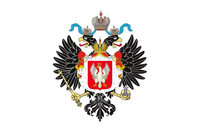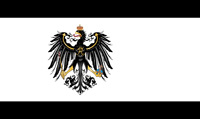World War I (1914-1918)

Great Retreat (Russian)
The Great Retreat was a strategic withdrawal from the Galicia-Poland salient conducted by the Imperial Russian Army during September 1915 in World War I. The Russians' critically under-equipped and (at the points of engagement) outnumbered forces suffered great losses in the Central Powers' July–September summer offensive operations, this leading to the Stavka ordering a withdrawal to shorten the front lines and avoid the potential encirclement of large Russian forces in the salient. While the withdrawal itself was relatively well conducted, it was a severe blow to Russian Russian Empire was an empire and the final period of the Russian monarchy from 1721 to 1917, ruling across large parts of Eurasia. The rise of the Russian Empire coincided with the decline of neighbouring rival powers: the Swedish Empire, the Polish–Lithuanian Commonwealth, Qajar Iran, the Ottoman Empire, and Qing China. Russia remains the third-largest empire in history, surpassed only by the British Empire and the Mongol Empire. morale.
Russian Empire was an empire and the final period of the Russian monarchy from 1721 to 1917, ruling across large parts of Eurasia. The rise of the Russian Empire coincided with the decline of neighbouring rival powers: the Swedish Empire, the Polish–Lithuanian Commonwealth, Qajar Iran, the Ottoman Empire, and Qing China. Russia remains the third-largest empire in history, surpassed only by the British Empire and the Mongol Empire. morale.
Background
During this period, the buildup of forces generally favoured the Central Powers. Four new German The German Empire, also referred to as Imperial Germany, the Second Reich, as well as simply Germany, was the period of the German Reich from the unification of Germany in 1871 until the November Revolution in 1918, when the German Reich changed its form of government from a monarchy to a republic. During its 47 years of existence, the German Empire became the industrial, technological, and scientific giant of Europe. armies, the 11th, 12th, Army of the Niemen and Army of the Bug were formed. Given the steady erosion of the Russian armies' combat power due to a poorly administered system of reinforcement, particularly of officers, this dramatically shifted the balance of power in the eastern theatre to the Central powers as 13 Central Powers armies faced 9 under-strength Russian armies. Under pressure from the Kaiser, Falkenhayn gave in to Hindenburg and Ludendorff's insistence on an offensive in the region. Although Ludendorff and Austro-Hungarian
The German Empire, also referred to as Imperial Germany, the Second Reich, as well as simply Germany, was the period of the German Reich from the unification of Germany in 1871 until the November Revolution in 1918, when the German Reich changed its form of government from a monarchy to a republic. During its 47 years of existence, the German Empire became the industrial, technological, and scientific giant of Europe. armies, the 11th, 12th, Army of the Niemen and Army of the Bug were formed. Given the steady erosion of the Russian armies' combat power due to a poorly administered system of reinforcement, particularly of officers, this dramatically shifted the balance of power in the eastern theatre to the Central powers as 13 Central Powers armies faced 9 under-strength Russian armies. Under pressure from the Kaiser, Falkenhayn gave in to Hindenburg and Ludendorff's insistence on an offensive in the region. Although Ludendorff and Austro-Hungarian Austria-Hungary, often referred to as the Austro-Hungarian Empire, the Dual Monarchy, or Austria, was a constitutional monarchy and great power in Central Europe between 1867 and 1918. Austria-Hungary was one of the Central Powers in World War I, which began with an Austro-Hungarian war declaration on the Kingdom of Serbia on 28 July 1914. General Staff Chief Conrad von Hötzendorf favored an encirclement operation (attacking the extreme north-east and south-east of the salient), just as the Stavka feared, Falkenhayn vetoed this on the grounds of the Central Powers' logistical limitations which confined them to slow advances along major railway lines.
Austria-Hungary, often referred to as the Austro-Hungarian Empire, the Dual Monarchy, or Austria, was a constitutional monarchy and great power in Central Europe between 1867 and 1918. Austria-Hungary was one of the Central Powers in World War I, which began with an Austro-Hungarian war declaration on the Kingdom of Serbia on 28 July 1914. General Staff Chief Conrad von Hötzendorf favored an encirclement operation (attacking the extreme north-east and south-east of the salient), just as the Stavka feared, Falkenhayn vetoed this on the grounds of the Central Powers' logistical limitations which confined them to slow advances along major railway lines.
Commanders of the Russian Field Armies in Poland Congress Poland, Congress Kingdom of Poland, or Russian Poland, formally known as the Kingdom of Poland, was a polity created in 1815 by the Congress of Vienna as a semi-autonomous Polish state, a successor to Napoleon's Duchy of Warsaw. It was established when the French ceded a part of Polish territory to the Russian Empire following France's defeat in the Napoleonic Wars. In 1915, during World War I, it was replaced by the German-controlled nominal Regency Kingdom until Poland regained independence in 1918. had already worked to persuade the Stavka to order a withdrawal from the salient, but the Stavka had felt unable to take such a bold move due to the political implications. The Stavka also did not permit tactical withdrawals within the salient such as the Second Army's proposal to withdraw behind the Vistula, forcing the field armies to hold tactically disadvantageous or even indefensible positions.
Congress Poland, Congress Kingdom of Poland, or Russian Poland, formally known as the Kingdom of Poland, was a polity created in 1815 by the Congress of Vienna as a semi-autonomous Polish state, a successor to Napoleon's Duchy of Warsaw. It was established when the French ceded a part of Polish territory to the Russian Empire following France's defeat in the Napoleonic Wars. In 1915, during World War I, it was replaced by the German-controlled nominal Regency Kingdom until Poland regained independence in 1918. had already worked to persuade the Stavka to order a withdrawal from the salient, but the Stavka had felt unable to take such a bold move due to the political implications. The Stavka also did not permit tactical withdrawals within the salient such as the Second Army's proposal to withdraw behind the Vistula, forcing the field armies to hold tactically disadvantageous or even indefensible positions.
Offensive
Despite heavy initial resistance, the Gorlice–Tarnów Offensive of May–June 1915 eventually resulted in a series of tactical breakthroughs and Mackensen's armies crossed the San River and re-took the Austro-Hungarian fortress at Przemyśl, the Russians leaving the Galician capital of Lvov on 22 June. At this point the Stavka began planning a retreat from the Poland salient as the Russians's forces in southern Poland withdrew northward to a new defensive line anchored on the Vistula river and the fortress of Ivanovgrod. Between 23 and 27 June the Germans established bridgeheads across the Dniester to the south, but were halted by Russian counterattacks from the east in July.
More worryingly for the Stavka, the German Tenth and Niemen armies pressed through on the extreme north end of the line in Courland. Although there was nothing worth defending in the area, the Stavka felt pressured to defend it on principle and so created a new army to defend the region. When this army was defeated and pushed back from Courland, the Stavka's over-estimation of the Germans logistical capabilities led to him fearing that these advances could be used as a springboard for further advances. It was feared that further successful advances in the north, combined with a fresh offensive in the south, could lead to the encirclement of the entire Poland-salient. Over-estimation of German naval capabilities also led to fears of an offensive thrust through Pskov to St Petersburg with the aid of amphibious landings in the capital itself.
Due to heavy losses in the Gorlice–Tarnów Offensive the Russian Army as a whole was a million combat troops, roughly 30%, short of its nominal strength of 1.8 million combat troops as well as being in an exposed position in the Poland Salient.
The Russian field armies at this time were critically short of modern weapons and ammunition of all kinds—artillery, machine guns, and even rifles. In the words of David Lloyd George, then the British The British Empire, was composed of the dominions, colonies, protectorates, mandates, and other territories ruled or administered by the United Kingdom and its predecessor states. At its height it was the largest empire in history and, for over a century, was the foremost global power. By the start of the 20th century, Germany and the United States had begun to challenge Britain's economic lead. Minister of Munitions, "The Russians, with their inferior equipment and serious shell deficiency, were quite unable to reply. Retreat was the only expedient open to them to save their armies from complete destruction."
The British Empire, was composed of the dominions, colonies, protectorates, mandates, and other territories ruled or administered by the United Kingdom and its predecessor states. At its height it was the largest empire in history and, for over a century, was the foremost global power. By the start of the 20th century, Germany and the United States had begun to challenge Britain's economic lead. Minister of Munitions, "The Russians, with their inferior equipment and serious shell deficiency, were quite unable to reply. Retreat was the only expedient open to them to save their armies from complete destruction."
The obsolescent fortresses of Novogeorgievsk, Ivangorod, Grodno, Osowiec, and Dvinsk, that were on or near the front lines at the time, contained considerable artillery, including some modern types. It was hoped that these could compensate for the temporary weakness of the infantry and render the Ivangorod-Lublin-Chełm line defensible.
On 13 July, the Central Powers' armies opened a new offensive across the entire front. By 17 July the forces Gallwitz's forces in the center-north had taken 80% losses, and although they had only been forced back only some 8 km they had to retreat across the Narew to avoid total annihilation. German advances in the far north in Latvia and Lithuania took the fortress of Grodno in a matter of days, when the Stavka had assumed that it could hold for weeks at the least, and with the renewal of Austro-Hungarian attacks in the south the Stavka now believed that the encirclement of the Poland-salient was inevitable without an immediate withdrawal and so ordered the abandonment of the defensive lines along the Narew and Vistula, trusting that the fortresses could cover the retreat of its forces.
By 13 July, the entire southern wing had been pushed back another 160 km (99 mi) to the Bug River, leaving only a small portion of Congress Poland in Russian hands, anchored on Warsaw and the Ivangorod fortress. On 22 July, armies of Central Powers crossed the Vistula river. In August, the Russian Fourth army left the Ivangorod fortress. With the continuing Russian retreat, Warsaw became isolated, and the German 12th Army (under Gallwitz) seized the opportunity and conquered it on 4–5 August.
New attacks by the German Eighth, Tenth and Twelfth armies moving south out of Prussia The Kingdom of Prussia was a German kingdom that constituted the state of Prussia between 1701 and 1918. It was the driving force behind the unification of Germany in 1871 and was the leading state of the German Empire until its dissolution in 1918. Although it took its name from the region called Prussia, it was based in the Margraviate of Brandenburg. Its capital was Berlin. soon caused even this front to collapse, sending the entire northern end of the Russian lines streaming backward, eventually forming a line running north-south at about the pre-war eastern Prussian border.
The Kingdom of Prussia was a German kingdom that constituted the state of Prussia between 1701 and 1918. It was the driving force behind the unification of Germany in 1871 and was the leading state of the German Empire until its dissolution in 1918. Although it took its name from the region called Prussia, it was based in the Margraviate of Brandenburg. Its capital was Berlin. soon caused even this front to collapse, sending the entire northern end of the Russian lines streaming backward, eventually forming a line running north-south at about the pre-war eastern Prussian border.
The Germans, after having received considerable reinforcements, took Brest-Litovsk on 25 August. On 19 September, Hindenburg's forces captured Vilna.
Aftermath
With their troops starving and their forces critically under-strength due to battle-casualties and particularly disease, the German advance was halted by Russian counter-attacks in late September. The new frontline ran from the Baltic sea to the Romanian border by way of the Belarusian forests and disease-ridden Pripyet Marshes. The new line was roughly on the line of Riga-Jakobstadt-Dünaburg-Baranovichi-Pinsk-Dubno-Ternopil.
On 21 August 1915, Tsar Nicholas II took advantage of the Stavka's blunders, in losing so many troops to the Central Powers' summer offensives and then retreating only when it was too late, to effectively neuter its power by removing Grand Duke Nicholas Nikolaevich from his post as its head, taking direct control of the army.
HISTORY

RESOURCES
This article uses material from the Wikipedia articles "World War", "World War I", and "Great Retreat (Russian)", which is released under the Creative Commons Attribution-Share-Alike License 3.0.
© Stories Preschool. All Rights Reserved.










